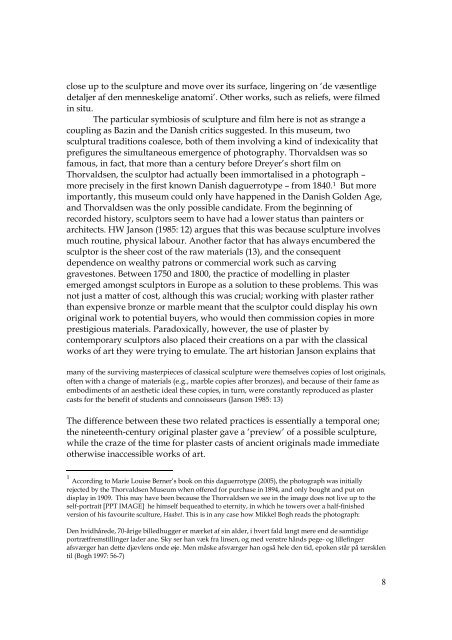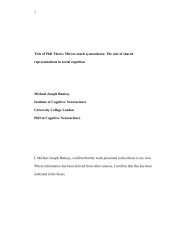A Cinema of Dust: On the Ontology of the Image from Dreyer's ...
A Cinema of Dust: On the Ontology of the Image from Dreyer's ...
A Cinema of Dust: On the Ontology of the Image from Dreyer's ...
Create successful ePaper yourself
Turn your PDF publications into a flip-book with our unique Google optimized e-Paper software.
close up to <strong>the</strong> sculpture and move over its surface, lingering on ‘de væsentlige<br />
detaljer af den menneskelige anatomi’. O<strong>the</strong>r works, such as reliefs, were filmed<br />
in situ.<br />
The particular symbiosis <strong>of</strong> sculpture and film here is not as strange a<br />
coupling as Bazin and <strong>the</strong> Danish critics suggested. In this museum, two<br />
sculptural traditions coalesce, both <strong>of</strong> <strong>the</strong>m involving a kind <strong>of</strong> indexicality that<br />
prefigures <strong>the</strong> simultaneous emergence <strong>of</strong> photography. Thorvaldsen was so<br />
famous, in fact, that more than a century before Dreyer’s short film on<br />
Thorvaldsen, <strong>the</strong> sculptor had actually been immortalised in a photograph –<br />
more precisely in <strong>the</strong> first known Danish daguerrotype – <strong>from</strong> 1840. 1 But more<br />
importantly, this museum could only have happened in <strong>the</strong> Danish Golden Age,<br />
and Thorvaldsen was <strong>the</strong> only possible candidate. From <strong>the</strong> beginning <strong>of</strong><br />
recorded history, sculptors seem to have had a lower status than painters or<br />
architects. HW Janson (1985: 12) argues that this was because sculpture involves<br />
much routine, physical labour. Ano<strong>the</strong>r factor that has always encumbered <strong>the</strong><br />
sculptor is <strong>the</strong> sheer cost <strong>of</strong> <strong>the</strong> raw materials (13), and <strong>the</strong> consequent<br />
dependence on wealthy patrons or commercial work such as carving<br />
gravestones. Between 1750 and 1800, <strong>the</strong> practice <strong>of</strong> modelling in plaster<br />
emerged amongst sculptors in Europe as a solution to <strong>the</strong>se problems. This was<br />
not just a matter <strong>of</strong> cost, although this was crucial; working with plaster ra<strong>the</strong>r<br />
than expensive bronze or marble meant that <strong>the</strong> sculptor could display his own<br />
original work to potential buyers, who would <strong>the</strong>n commission copies in more<br />
prestigious materials. Paradoxically, however, <strong>the</strong> use <strong>of</strong> plaster by<br />
contemporary sculptors also placed <strong>the</strong>ir creations on a par with <strong>the</strong> classical<br />
works <strong>of</strong> art <strong>the</strong>y were trying to emulate. The art historian Janson explains that<br />
many <strong>of</strong> <strong>the</strong> surviving masterpieces <strong>of</strong> classical sculpture were <strong>the</strong>mselves copies <strong>of</strong> lost originals,<br />
<strong>of</strong>ten with a change <strong>of</strong> materials (e.g., marble copies after bronzes), and because <strong>of</strong> <strong>the</strong>ir fame as<br />
embodiments <strong>of</strong> an aes<strong>the</strong>tic ideal <strong>the</strong>se copies, in turn, were constantly reproduced as plaster<br />
casts for <strong>the</strong> benefit <strong>of</strong> students and connoisseurs (Janson 1985: 13)<br />
The difference between <strong>the</strong>se two related practices is essentially a temporal one;<br />
<strong>the</strong> nineteenth-century original plaster gave a ‘preview’ <strong>of</strong> a possible sculpture,<br />
while <strong>the</strong> craze <strong>of</strong> <strong>the</strong> time for plaster casts <strong>of</strong> ancient originals made immediate<br />
o<strong>the</strong>rwise inaccessible works <strong>of</strong> art.<br />
1 According to Marie Louise Berner’s book on this daguerrotype (2005), <strong>the</strong> photograph was initially<br />
rejected by <strong>the</strong> Thorvaldsen Museum when <strong>of</strong>fered for purchase in 1894, and only bought and put on<br />
display in 1909. This may have been because <strong>the</strong> Thorvaldsen we see in <strong>the</strong> image does not live up to <strong>the</strong><br />
self-portrait [PPT IMAGE] he himself bequea<strong>the</strong>d to eternity, in which he towers over a half-finished<br />
version <strong>of</strong> his favourite sculture, Haabet. This is in any case how Mikkel Bogh reads <strong>the</strong> photograph:<br />
Den hvidhårede, 70-årige billedhugger er mærket af sin alder, i hvert fald langt mere end de samtidige<br />
portrætfremstillinger lader ane. Sky ser han væk fra linsen, og med venstre hånds pege- og lillefinger<br />
afsværger han dette djævlens onde øje. Men måske afsværger han også hele den tid, epoken står på tærsklen<br />
til (Bogh 1997: 56-7)<br />
8
















